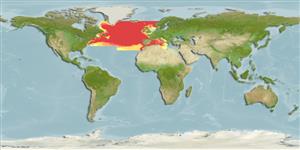Environment: milieu / climate zone / depth range / distribution range
Écologie
marin bathypélagique; océanodrome; profondeur 50 - 1032 m (Ref. 56504), usually 200 - 600 m (Ref. 35388). Deep-water; 65°N - 30°N, 77°W - 21°E
Atlantic Ocean: restricted to the North Atlantic and adjacent seas.
Taille / Poids / Âge
Maturity: Lm ? range ? - ? cm
Max length : 50.0 cm SL mâle / non sexé; (Ref. 35388)
Depth range from 50-1000 m (ref. 04473) and up to 1032 m in the eastern Ionian Sea (Ref. 56504). Epipelagic to bathypelagic (Ref. 58426); also mesopelagic (Ref. 5951). Feeds on fishes, crustaceans and occasionally planktonic organisms (Ref. 5759). Spawns from March to September, larvae near the surface (Ref. 35388).
Life cycle and mating behavior
Maturité | Reproduction | Frai | Œufs | Fécondité | Larves
Larvae are found near the surface.
Post, A., 1990. Paralepididae. p. 373-384. In J.C. Quero, J.C. Hureau, C. Karrer, A. Post and L. Saldanha (eds.) Check-list of the fishes of the eastern tropical Atlantic (CLOFETA). JNICT, Lisbon; SEI, Paris; and UNESCO, Paris. Vol. 1. (Ref. 4473)
Statut dans la liste rouge de l'IUCN (Ref. 130435: Version 2024-2)
Menace pour l'homme
Harmless
Utilisations par l'homme
Pêcheries: sans intérêt
Outils
Articles particuliers
Télécharger en XML
Sources Internet
Estimates based on models
Preferred temperature (Ref.
123201): 2.2 - 14, mean 7.4 °C (based on 462 cells).
Phylogenetic diversity index (Ref.
82804): PD
50 = 0.5625 [Uniqueness, from 0.5 = low to 2.0 = high].
Bayesian length-weight: a=0.00224 (0.00090 - 0.00555), b=3.14 (2.92 - 3.36), in cm total length, based on LWR estimates for this (Sub)family-body shape (Ref.
93245).
Niveau trophique (Ref.
69278): 4.1 ±0.70 se; based on food items.
Résilience (Ref.
120179): Milieu, temps minimum de doublement de population : 1,4 à 4,4 années (Preliminary K or Fecundity.).
Fishing Vulnerability (Ref.
59153): Moderate vulnerability (44 of 100).
Nutrients (Ref.
124155): Calcium = 30.6 [9.3, 91.7] mg/100g; Iron = 0.35 [0.11, 1.10] mg/100g; Protein = 16.2 [13.1, 18.8] %; Omega3 = 0.105 [0.028, 0.323] g/100g; Selenium = 21.1 [6.3, 65.8] μg/100g; VitaminA = 11.8 [1.2, 92.8] μg/100g; Zinc = 0.442 [0.227, 0.867] mg/100g (wet weight);
